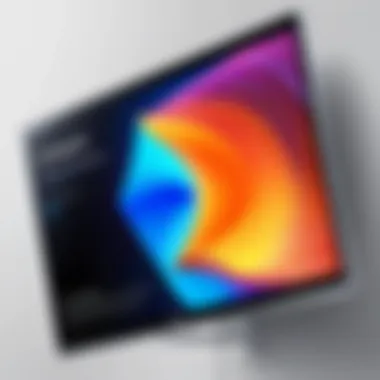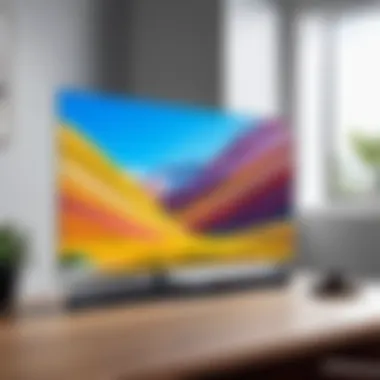Understanding the Peak Brightness of Samsung QN90A


Intro
The Samsung QN90A television is at the forefront of display technology and offers an impressive peak brightness that can transform the viewing experience. This article unpacks the details of the QN90A’s peak brightness, underscoring its relevance for both casual viewers and discerning tech enthusiasts. Understanding peak brightness isn't just about numbers; it's about how the technology interacts with diverse content and environments.
Hardware Overview
The Samsung QN90A is not merely a display; it is a complex amalgamation of hardware designed to deliver superior image quality. Its ability to generate high peak brightness levels significantly enhances its performance across various viewing conditions.
Specifications
Some crucial specifications of the QN90A include:
- Panel Type: Neo QLED
- Backlighting: Quantum Mini LED
- Peak Brightness: Up to 2000 nits in HDR content
- Screen Size Options: Ranges from 50 to 85 inches
These specifications are enough to pique the interest of any tech professional, but what do they mean in practice?
Performance Metrics
The performance metrics are a testament to the QN90A's capabilities:
- Color Accuracy: High color volume ensures vibrant images even at high brightness.
- Black Level Performance: With local dimming technology, the QN90A achieves remarkable contrast.
- Response Time: Minimal lag time for fast-moving scenes, essential for gamers and sports enthusiasts.
In practical applications, such performance metrics translate into a viewing experience that is both immersive and enjoyable. The capability to reach up to 2000 nits allows the QN90A to produce brilliant highlight details in bright environments, making it an ideal choice for daylight viewing.
Software Analysis
As important as the hardware is, software plays an equally significant role in user experience and feature functionality in the QN90A. Samsung has developed an intuitive interface that enhances user interaction with the technology.
Features and Functionality
Key features include:
- Smart Hub: A centralized platform for accessing apps, streaming services, and more.
- AI Picture Optimization: This feature adjusts performance based on content type.
- Adaptive Picture: The screen automatically adjusts brightness according to ambient light conditions.
These features optimize the viewing experience, ensuring that users receive the best visual performance regardless of the viewing context.
User Interface and Experience
The interface is seamless, with quick navigation through menus. According to user reviews on platforms like Reddit, the experience is mostly positive. Viewers appreciate its ease of use, especially with varied content, making it suitable for families with diverse viewing preferences.
"The QN90A's peak brightness transforms how I watch movies. Daytime shows have never looked better!"
End
Preamble to Samsung QN90A
In the realm of display technology, the Samsung QN90A stands out as a beacon of innovation. Understanding its features, especially its peak brightness, is essential for anyone looking to make an informed decision. This section highlights the key aspects of the QN90A while explaining why its performance is pivotal for both casual viewers and enthusiasts. The advances in brightness technology enhance overall picture quality and viewing experience significantly.
Overview of Samsung QN90A


The Samsung QN90A is a part of Samsung’s Neo QLED television lineup, employing a mini-LED backlighting system that offers enhanced contrast and vivid colors. This model is notable for its ability to deliver exceptional brightness levels, which is what sets it apart from standard LED televisions. The Quantum Matrix technology ensures that the backlight can be controlled with greater precision, thereby improving the overall viewing experience. This leads to deeper blacks and brighter highlights, making it particularly good for watching HDR content. Insights into its design, build quality, and features provide a better understanding of its place in the premium television market.
State-of-the-Art Display Technology
The QN90A utilizes cutting-edge technologies that contribute to its peak brightness capabilities. One of the central elements is the Quantum Dot technology, which allows for enhanced color reproduction at higher brightness levels. The mini-LED backlighting system also plays a crucial role by increasing the number of localized dimming zones, enabling better adjustments to contrast without blooming.
The result is a display that achieves impressive brightness while maintaining color accuracy. Peak brightness is not just a number; it vastly affects how content is viewed. Bright scenes are rendered with stunning clarity and detail, which is important in both dark and well-lit environments. By adopting these advanced technologies, Samsung effectively addresses the demanding requirements of modern viewing habits.
"Peak brightness directly influences the viewer's experience, especially in HDR scenarios where highlights are essential for realism."
The QN90A is thus designed not just for casual viewing, but to meet the expectations of professionals and enthusiasts who demand more from their displays.
Understanding Peak Brightness
Peak brightness is a significant factor in evaluating the performance of modern televisions, especially models like the Samsung QN90A. This term refers to the maximum luminance that a display can achieve under optimal conditions. Understanding peak brightness is crucial as it directly impacts how content is viewed, particularly in varied lighting environments. High peak brightness contributes to better contrast, allowing brighter highlights in scenes. This is particularly important for HDR (High Dynamic Range) content, where detail in highlights and shadows is crucial for an immersive experience.
Defining Peak Brightness
Peak brightness is measured in nits, where one nit is equal to one candela per square meter. This metric quantifies how much light a display can emit at its brightest point. Different technologies produce varying levels of brightness; for instance, OLEDs typically excel in darker scenes due to their ability to turn off individual pixels completely, while LEDs can shine brighter overall, making them preferable for well-lit environments. The Samsung QN90A employs Quantum Dot technology alongside a Mini-LED backlight, which enables it to reach impressive peak brightness levels, often exceeding one thousand nits. This capability ensures that bright highlights in scenes do not wash out, providing a richer visual experience.
Importance in Modern Displays
The relevance of peak brightness in contemporary displays cannot be overstated. With the rise of HDR content, displays need to reproduce a wider range of brightness levels. The increase in peak brightness allows for more vivid colors and enhanced details in both shadowed and illuminated areas. In contrast, displays with lower peak brightness may struggle to showcase HDR content effectively, potentially leading to a flat or unappealing viewing experience.
Moreover, the varying conditions under which users consume content necessitate high peak brightness. In bright rooms, having a display that can achieve high lumens can make a marked difference in visibility and enjoyment. When compared to quantum dot displays, the QN90A's peak brightness gives it an edge in usability across diverse lighting conditions. Therefore, for tech enthusiasts and professionals assessing the Samsung QN90A, recognizing its peak brightness as a pivotal feature is essential for understanding its overall performance and value.
"Peak brightness is not just a number; it defines the viewing experience, shaping how consumers enjoy content across different environments."
Understanding these nuances surrounding peak brightness will allow users to appreciate the Samsung QN90A’s capabilities more deeply.
Technical Specifications of QN90A
The technical specifications of the Samsung QN90A are critical to understanding its peak brightness and overall performance. These details reflect not only the capabilities of the display but also determine how it performs in various viewing conditions. A thorough comprehension of this topic can benefit tech professionals and enthusiasts in making informed decisions about display technology.
The QN90A utilizes advanced panel technology which is fundamental for achieving superior peak brightness. Moreover, the backlighting system plays a significant role in how light is emitted across the screen. The combination of these elements provides deeper insights into viewing experiences that the television can deliver, especially in high dynamic range (HDR) content scenarios. Attention to detail in the specifications can reveal the advantages or limitations in performance, allowing for better comparisons with competitors.
Panel Type and Backlighting
The Samsung QN90A features a Neo QLED panel, which integrates Quantum Dot technology combined with a Mini LED backlight. This configuration enhances contrast and color accuracy significantly. The Mini LED technology stands out in that it comprises smaller LEDs to illuminate the display. This allows for finer control over specific areas of the screen, facilitating better brightness distribution and minimizing blooming effects.
The advantages of using a Neo QLED panel extend beyond mere brightness.
- Improved Contrast: With more controlled backlighting, dark scenes maintain detail without unwanted light bleed.
- Color Accuracy: Quantum Dot technology enables the display to achieve a wider color gamut.
The result is a television that can deliver stunning visuals, adapting effectively to the content displayed.
Brightness Levels in Different Modes
Brightness levels on the QN90A vary across different modes, which is essential for optimizing the viewing experience based on environmental conditions and content type. The television includes several preset modes such as:
- Standard Mode: Offers a balanced brightness for general use.
- Movie Mode: Adjusts brightness to suit cinematic experiences, often lowering brightness to enhance detail in shadows.
- Dynamic Mode: This setting maximizes brightness, making it ideal for bright rooms or detailed content.


In HDR mode, peak brightness can reach impressive levels, making HDR content stand out significantly. This flexibility is crucial because viewers may encounter various lighting conditions depending on the time of day and room setup. Furthermore, these variations can significantly affect the viewing experience, showcasing how technical specifications influence practical applications.
"A well-calibrated display can transform the viewing experience and highlight the importance of technical specifications."
Understanding how these dynamic options function will ensure that each user can tailor their viewing environment for optimal enjoyment. The technical specifications of the Samsung QN90A illustrate the harmonious combination of technology and performance, emphasizing the display's capability to adjust to diverse requirements.
Comparative Brightness Analysis
Comparative brightness analysis is essential in understanding how the Samsung QN90A stands against its competitors in the market. This analysis not only illuminates the technical specifications but also demonstrates the practical implications of brightness levels in real-world scenarios. By examining how the QN90A performs relative to other brands and models, users can better appreciate its capabilities in various lighting conditions.
Samsung QN90A vs. Competitors
The Samsung QN90A is distinguished by its impressive peak brightness, which significantly enhances its viewing capabilities. To appreciate its performance, it is vital to compare it with similar OLED and QLED models. For example, LG's OLED G1 is known for its excellent contrast, but often does not reach the same brightness levels as the QN90A.
- QN90A Brightness: Capable of achieving peak brightness levels that can exceed 2,500 nits while displaying HDR content.
- Competitors: Similar models may range from 1,500 to 2,000 nits, resulting in a marked difference in how bright scenes are rendered.
Samsung’s innovative Quantum HDR technology allows the QN90A to excel in dynamic content, where bright highlights and dark shadows must coexist. Each brand's technology brings unique strengths and weaknesses that affect performance. Moreover, the analysis should also include the impact of local dimming zones, color accuracy, and reflections.
"In a bright room, peak brightness can significantly affect how much detail is visible in both dark and bright scenes."
Impact of Brightness on Viewing Experience
Understanding how brightness affects the viewing experience is crucial. It directly influences how users perceive image quality. The Samsung QN90A's ability to produce high brightness levels yields a more immersive experience. Here are the key areas affected by brightness:
- HDR Performance: High Dynamic Range content is best experienced with maximal brightness. The QN90A ensures that bright elements in scenes pop, offering a more lifelike appearance.
- Contrast Ratios: More brightness results in better distinction between the darkest and the lightest parts of images.
- Adaptability to Environments: In well-lit rooms, high brightness ensures that picture quality remains consistent without washing out. Conversely, in darker setups, the QN90A's high brightness still maintains detail across various light levels.
Real-World Applications of Peak Brightness
Peak brightness plays a critical role in enhancing the overall viewing experience of the Samsung QN90A. This capability is not merely a technical specification; it has real-world implications that significantly enrich the interaction between the viewer and the content displayed. With the emergence of high-dynamic-range (HDR) technology, understanding how peak brightness functions can provide deeper insights into its importance.
Impact on HDR Content
HDR content often demands higher brightness levels to effectively convey the producer's artistic intent. In essence, peak brightness allows for brighter highlights and deeper shadows, creating a more dynamic range that engages the viewer’s senses. For instance, scenes with sunlight, reflections, or explosions showcase the capabilities of HDR. The Samsung QN90A shines in this regard, reaching impressive brightness levels that contribute to a vivid representation of those high-contrast moments.
Moreover, when watching HDR movies or gaming at proper settings, the enhanced brightness helps reveal intricate details that might otherwise be lost in a dimly lit display. The algorithm used to optimize brightness ensures that each frame retains its integrity, thus maintaining the director's vision. This capability can turn an ordinary viewing session into an immersive experience.
Influences of Ambient Light
The user environment significantly impacts how peak brightness enhances the viewing experience. Ambient light can dilute the impact of color and contrast on a screen. The Samsung QN90A addresses this with its ability to adapt brightness levels according to environmental conditions. For example, during daylight hours, the television's peak brightness allows it to counteract the washout effect caused by natural sunlight.
When watching in a bright room, such as a living room with large windows, the QN90A can maintain clarity and color accuracy without being compromised by surrounding light. Conversely, in a dark room, the same brightness will adapt to enhance contrast, ensuring that dark scenes retain their nuance.
In summary, the real-world applications of peak brightness are significant. They influence how content is perceived under varying conditions and enhance the engagement of viewers with the material presented. This adaptability not only aligns with user needs but also elevates the standard for future display technologies.
"Peak brightness isn't just a number; it's the gateway to experiencing content as it was intended to be seen."
With this understanding, we can begin to appreciate how the Samsung QN90A leverages peak brightness to cater to diverse viewing contexts, underlining its role as a premier choice for both casual viewers and dedicated enthusiasts.
User Experience and Feedback


User experience plays a crucial role in assessing the peak brightness of the Samsung QN90A. Evaluating how brightness affects viewing can inform both buyers and manufacturers. The feedback from users offers insights into real-world performance, which is essential for understanding the impact of brightness in various settings. Factors such as ambient light, content type, and individual preferences influence the overall experience.
The peak brightness may appeal to different user groups, from movie enthusiasts seeking immersive HDR visuals to gamers who thrive on quick response times and vivid graphics. Understanding consumer experiences leads to better product designs and informed purchasing choices.
Expert Reviews on Brightness Performance
Expert reviews provide a rigorous analysis of the brightness performance of the Samsung QN90A. Industry critics often focus on specific metrics, such as maximum brightness levels in HDR content and the consistency of brightness across various screen sizes. Reviews from TechRadar and CNET highlight how the QN90A excels in both bright and dark room conditions. This versatility is a significant consideration for potential buyers.
Observers note that the peak brightness can reach up to 2,000 nits, which is impressive for an LCD panel. This capability allows viewers to enjoy HDR content as intended. Experts frequently recommend the QN90A for users in well-lit environments, where higher brightness contributes to clearer images. However, they also caution that excessive brightness can lead to fatigue during longer viewing sessions. Overall, expert evaluations emphasize balanced settings that optimize the viewing experience without overwhelming the viewer.
Consumer Insights and Ratings
Consumer insights reveal how real users perceive the peak brightness of the Samsung QN90A. Ratings on platforms like Reddit and Amazon show a favorable reception. Many users note that the television's brightness delivers crisp imagery, enhancing their overall viewing experience. The feedback often highlights ease of use in adjusting brightness levels based on the ambient light conditions.
Moreover, users express satisfaction with the TV's ability to handle varied content—be it sports, movies, or games—without compromising quality. The ratings are high, generally averaging above four stars. Reviewers consistently mention features like adaptive brightness, which automatically adjusts based on surroundings, helping to maintain a consistent experience. This function is particularly praised for enhancing the performance in dimly lit scenarios.
In summary, user experiences and consumer feedback underscore the significance of peak brightness. The combination of expert reviews and consumer ratings delivers a comprehensive understanding of how this feature shapes the Samsung QN90A's appeal.
Future of Display Technologies
The future of display technologies is a critical area of interest, particularly when one examines the capabilities of devices like the Samsung QN90A. As advancements in brightness technology continue to evolve, several elements emerge that impose a significant impact on both consumer choices and manufacturers' strategies. Understanding these advancements allows us to appreciate how peak brightness shapes not only viewing experiences but also the broader entertainment landscape. This topic is essential as it encapsulates the intersection between technological progress and market demands.
Advancements in Brightness Technology
Brightness technology is witnessing rapid advancements that enhance the performance of displays. One of the most notable improvements is the integration of Mini LED and Micro LED technologies. These innovations enable higher peak brightness levels while maintaining efficient energy consumption. This means that screens can display vivid colors and intricate details in bright environments without serious burnout.
Other developments include improved local dimming capabilities. This feature allows televisions to control brightness at a granular level, making dark areas darker and bright areas brighter, thus achieving a more dynamic and engaging visual experience. Notably, the Samsung QN90A utilizes Quantum Dot technology to achieve impressive color accuracy and brightness, elevating content enjoyment.
Moreover, HDR (high dynamic range) formats are becoming more widely adopted. Formats such as HDR10+, Dolby Vision, and HLG enable displays to take full advantage of enhanced brightness levels. This approach results in richer images that showcase the full spectrum of light and color, which elevates the viewing experience significantly.
Potential Market Trends
Looking ahead, several market trends are poised to influence the landscape of display technologies. The increasing demand for ultra-high-definition content is paving the way for displays with superior peak brightness. As streaming services and content creators embrace 4K and 8K resolutions, consumers will increasingly expect televisions that can accurately reproduce these formats with vivid brightness and detail.
Another trend is the shift toward OLED technology. While LEDs provide excellent brightness and contrast, OLED offers unmatched color depth and viewing angles. As manufacturers find ways to optimize OLED’s brightness without sacrificing quality, it could become the preferred choice for high-end consumers. Alongside OLED, advances in Micro OLED technology are expected to make strides, allowing for even deeper blacks and further enhanced brightness.
Additionally, the growing awareness of eye comfort and health will influence consumer preferences. Technology that minimizes blue light and flicker while maximizing brightness will get attention. This trend aligns with an overall move towards wellness-oriented technological solutions.
Integrating advanced brightness technologies not only improves aesthetic experiences but also enhances viewer comfort and engagement.
In summary, the future of display technologies is set to be influenced by advancements in brightness and evolving consumer expectations. Keeping a close watch on these trends will be vital for tech enthusiasts and professionals alike, as they navigate the complexities and innovations driving the display sector.
Ending
The conclusion of this article brings together critical insights about the peak brightness of the Samsung QN90A. This technology is crucial for any serious discussion about modern display performance. Understanding peak brightness affects not just viewing experience but also how the television interacts with various content types and ambient conditions.
In essence, peak brightness represents a measure of how bright the display can get under optimal conditions. For the Samsung QN90A, this capability means dealing with HDR content efficiently and making images vivid and realistic. Furthermore, acknowledging the contrast ratio and color accuracy offers insights into overall picture quality.
Summary of Key Points
- Peak Brightness Defined: It is a measure of maximum brightness the television can achieve. The QN90A excels in this area, providing clarity in various lighting environments.
- Impact on HDR: The benefits of peak brightness are most evident in HDR content where bright highlights can enhance the viewing experience significantly.
- Comparison with Competitors: The QN90A stands out when compared to similar products in the market, showcasing superior performance in brightness.
- User Feedback: Consumer insights indicate high satisfaction with brightness performance, reflecting its importance.
Final Thoughts on QN90A's Peak Brightness
"Understanding brightness levels offers a window into how effectively a display can reproduce content in varying conditions."
In summary, the Samsung QN90A sets a benchmark in the realm of peak brightness, providing substantial value for viewers who prioritize picture quality.



